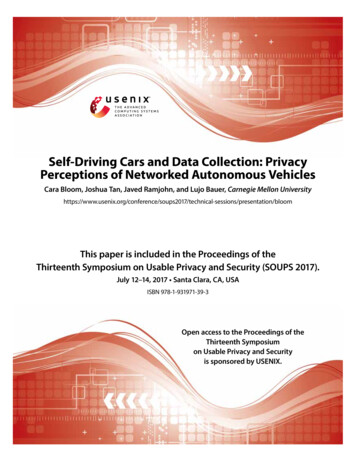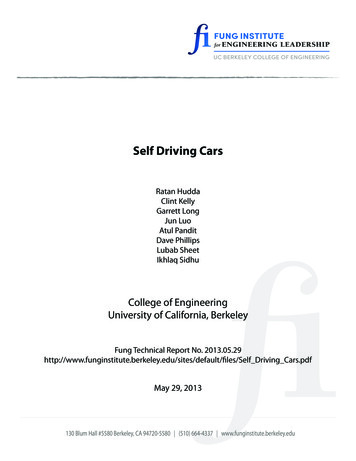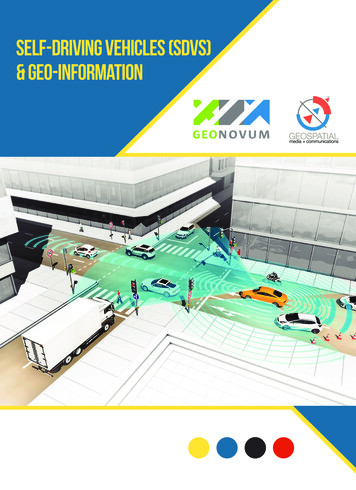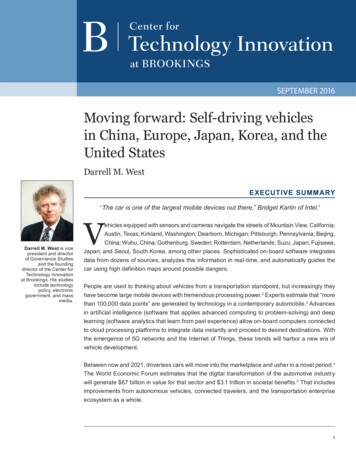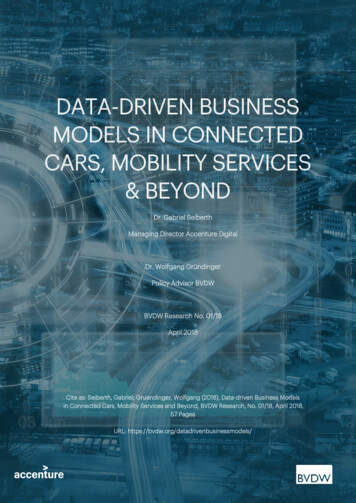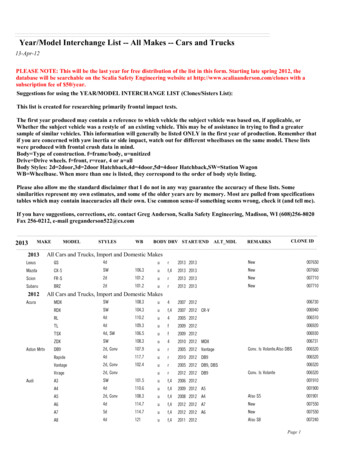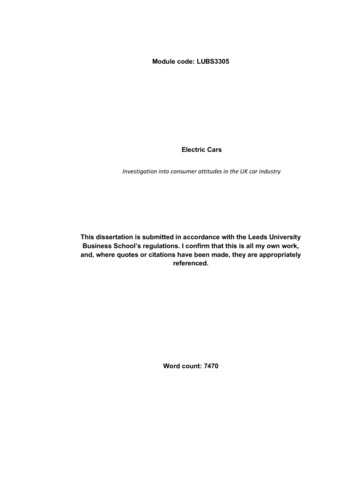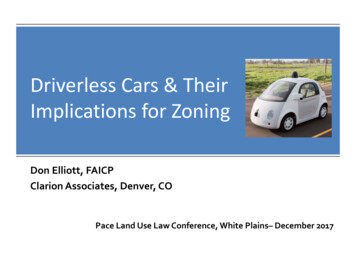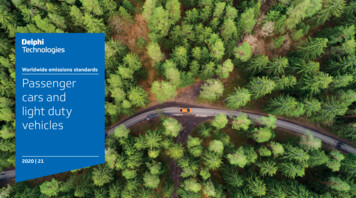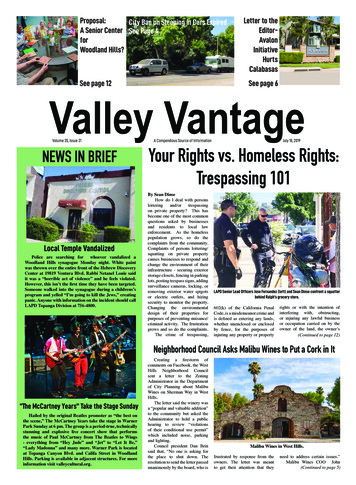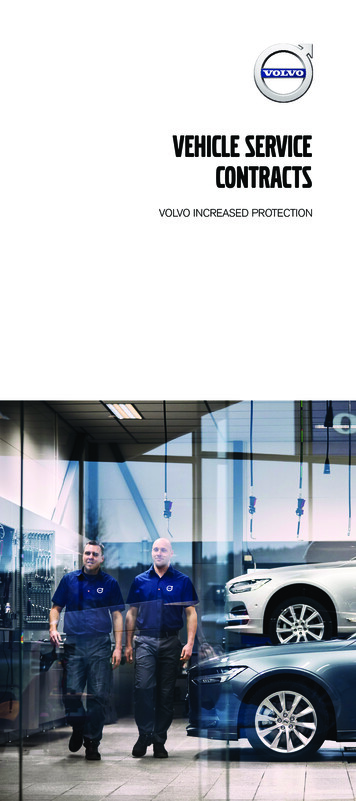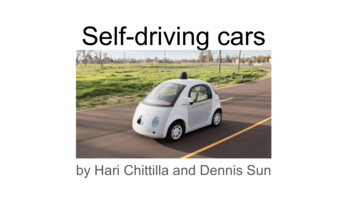
Transcription
Self-driving carsby Hari Chittilla and Dennis Sun
QuestionHow would you define a self-driving car?
Definition: What is an autonomous car? Autonomous Car: A driverless vehicle capable of fulfilling the maintransportation capabilities of a traditional car.
Classifications of Autonomy according to the NHTSA. Level 0: The driver completely controls the vehicle at all times.Level 1: Individual vehicle controls are automated, such as electronic stabilitycontrol or automatic braking.Level 2: At least two controls can be automated in unison, such as adaptivecruise control in combination with lane keeping.Level 3: The driver can fully cede control of all safety-critical functions in certainconditions and the car provides a "sufficiently comfortable transition time" for thedriver to do so.Level 4: The vehicle performs all safety-critical functions for the entire trip, withthe driver not expected to control the vehicle at any time.
PurposeWhat kinds of things does a self-driving car need to be able to do?
Purpose navigate to a given destination based on passenger-provided instructions avoid environmental obstacles safely avoid other vehicles obey the laws of the road
History
Linrrican Wonder Houdina Radio Control, 1925Made by Francis P HoudinaTraveled up Broadway and down Fifth Avenue through the thick of the trafficjam
Futurama sponsored by General Motors at the 1939World's Fairradio-controlled electric cars propelled via electromagnetic fields
RCA Labs 1953- RCA Labs built a miniature car guided and controlled by wires1958- Full sized system made developed in collab. with General Motors
Mercedes Benz 1980’s- vision-guided Mercedes-Benz robotic van designed by Ernst Dickmanns and his team at the Bundeswehr UniversityMunichachieved a speed of 39 miles per hour (63 km/h) on streets without traffic
History Carnegie Mellon’s Navlab and ALV projects in 1984Mercedes-Benz and Budeswehr University Munich’s EUREKA PromethiusProject in 1987Others: Continental Automotive Systems, IAV, Autoliv Inc., Bosch, Nissan,Renault, Toyota, Audi, Volvo, Peugeot, AKKA Technologies, Vislab fromUniversity of Parma, Oxford University, Google these companies were more prevalent 2010-2015
DEMO I, II, and III US-funded military effortsdemonstrated the ability of unmanned ground vehicles to navigate miles ofdifficult off-road terrain
The Grand Challenges (I, II, and III) a fundamental problem in science or engineering, with broad applications,whose solution would be enabled by the application of high performancecomputing resources that could become available in the near futureGrand Challenges were US policy terms set as goals in the late 1980s forfunding high-performance computing and communications research
DARPA Grand Challenge (2004) DARPA (Defense Advanced Research Projects Agency)March 13, 2004 in the Mojave DesertNo cars finishedSandstorm from CMU traveled furthest: 11.78 km (7.32 mi)
Grand Challenge II (2005) 6:40am on October 8, 2005
Grand Challenge III (2007) aka Urban Challenge November 3, 2007 at the site of the now-closed George Air Force Base96 km (60 mi) urban area course, to be completed in less than 6 hoursobey all traffic regulations while negotiating with other traffic and obstaclesand merging into traffic
Google’s Technology 150,000 in equipment including a 70,000 LIDAR system The range finder mounted on the top is a Velodyne 64-beam laser. This laserallows the vehicle to generate a detailed 3D map of its environment. The car uses data collected from these mechanisms to drive itself.
Google’s Technology
How it works: Lidar system Laser radarThe system detects obstacles and tells the car when to avoid them tonavigate safely.It uses a 3D point cloud output provide the necessary data for robot softwareto determine where potential obstacles exist in the environment and wherethe car is is located relative to those obstacles.
How it works: Velodyne Company started experimenting with laser distance in 2005 with the DARPAGrand ChallengeSince then, they have vastly reduced the size of the sensor and weight whileimproving its performance.It is a premier lidar system
How does communication among driverless carswork? vehicles and roadside units as the communicating nodes DSRC devices- 5.9 GHz band with bandwith of 75 MHz- range of 1000m
Communication among driverless cars cont. Smart intersections intersections with no lights that communicate for autonomous cars 2012- University of Texas in Austin
Google’s Track Record As of July 2015, Google’s cars have been involved in 14 “minor accidents”. only one had resulted in minor injuriesThey’ve logged 1.7 million miles, and Google claims not a single collision wascaused by the self-driving mechanisms
Are we going to see Google on the road soon?Google plans to make these cars available to the public in 2020.
Other Companies involved (since 1987)Mercedes-BenzAudiGeneral taTesla
Mercedes Benz
Audi
Tesla’s Current Auto Pilot
Potential advantages being able to get things done while in traffic or on the road increase road capacity fewer traffic collisions. Experts estimate 300,000 lives can be saved perdecade higher speed limits reduction in traffic police removal of limitations on drivers — age and sobriety won’t be an issue
Potential obstacles Liability for damage Resistance by individuals to forfeit control of their cars Software reliability Implementation of legal framework and establishment of governmentregulations for self-driving cars Drivers being inexperienced if situations arose requiring manual driving Loss of driving-related jobs Loss of privacy
LegislationIn the United States, state vehicle codes generally do not envisage — but do notnecessarily prohibit — highly automated vehicles.
Public OpinionWhat do you think?Would you be comfortable with an autonomous vehicle?
Public Opinion of 2,006 surveyed consumers, 49% would be comfortable Accenture, 2011of 17,400 owners, 37% would be interested purchasing a self driving 2012, J.D. Power and Associates dropped to 20% if the technology costs 3000 or moreof 1,000 German drivers, 10% undecided, 44% skeptical, 24% hostile 2012, automotive researcher Puls
Discussion: Liability Situation: If a traditional automobile gets hit by a driverless car, who isresponsible?Opinion?Take a minute talk with the person next to you and decide what you think.
Discussion: Children Situation: Driverless cars may one day be able to pick a child up from schooland take him home if the laws permitOpinion?
Discussion: Licenses If driverless cars are a thing of the future, will driver licenses be a thing of thepast?Opinion?Take a minute talk with the person next to you and decide what you think.
Discussion: Morals If there was a choice to swerve into a schoolbus and potentially kill thechildren onboard but save the driver, or divert the car to kill the driver but savethe children, how should the car be programmed?A real life application of The Trolley ProblemOpinions?Take a minute talk with the person next to you and decide what you think.
Discussion: Jobs Will there still be a demand for auto insurance? What about publictransportation and taxi jobs, just to name a few?Opinion?
Predictions: Possible Developments By 2016, Mercedes plans to introduce "Autobahn Pilot" aka Highway Pilot, thesystem allows a car to automatically pass someone while driving on ahighway. By early 2017, the US Department of Transportation hopes to publish a rulemandating vehicle-to-vehicle (V2V) communication. By 2018, Elon Musk expects Tesla Motors to have developed mature serialproduction version of fully self-driving cars, where the driver can fall asleepbehind the wheel.
Predictions: Possible Developments By 2018, Nissan anticipates to have a feature that can allow the vehiclemaneuver its way on multi-lane highways. By 2020, Volvo envisages having cars in which passengers would be immunefrom injuries. By 2020, GM, Mercedes-Benz, Audi, Nissan, BMW, Renault, Tesla, Googleand Toyota all expect to sell vehicles that can drive themselves at least part ofthe time By 2020, Google autonomous car project head's goal to have all outstandingproblems with the autonomous car be resolved.
Questions?
Thanks Dr. Ming Lin
Definition: What is an autonomous car? Autonomous Car: A driverless vehicle capable of fulfilling the main transportation capabilities of a traditional car. Classifications of Autonomy according to the NHTSA. Level 0: The driver completely controls the vehicle at all times. Level 1: Individual vehicle controls are automated, such as electronic stability control or automatic braking. Level 2 .
